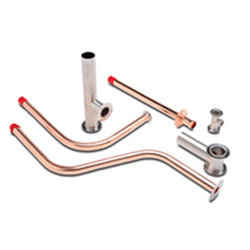Quantum Heat Treaters
Product Range
Fact Sheet
- Location:Tamil Nadu, India
- Year of Establishment:1999
- Main Products:Heat Treatment Services, Magnetic Shielding
- Reviews & Rating:
High Temperature Hydrogen (Reduction) Atmosphere Brazing
The hi-tech High Temperature Hydrogen (Reduction) Atmosphere Brazing is a brazing process that uses the cleaning (reducing) properties of high purity hydrogen to improve the flow characteristics of the braze alloy.
- FOB PriceNA
- Min Order QuantityNA
- Payment TermsNA
Other Details
The hi-tech High Temperature Hydrogen (Reduction) Atmosphere Brazing is a brazing process that uses the cleaning (reducing) properties of high purity hydrogen to improve the flow characteristics of the braze alloy. The hydrogen atmosphere reduces surface oxides on the parent material, enabling the braze alloy to flow (wet) more effectively to create a high integrity braze joint.
Benefits:
- Cleanliness – the reduction of surface oxides on the parent material improves the cleanliness and integrity of the braze joint.
- Increased braze alloy and parent material options – enables the use of high vapor pressure braze alloys and parent materials that cannot be brazed within a vacuum atmosphere.
Applications & Materials:
- Medical devices
- Electronic devices
- Aerospace parts (precision machined stainless steel components)
- High vapor pressure brazes alloys (Cu, Ag, etc.)
- High cleanliness assemblies
Hydrogen brazing can be applied to a multitude of materials such as stainless steel, copper and some nickel based alloys. Titanium alloys cannot be brazed in a hydrogen atmosphere. Hydrogen brazing reduces surface oxides at the faying surfaces, resulting in a clean, high integrity braze joint that improves the service characteristics of the finished part.
Hydrogen Brazing Properties:
- Due to the byproducts of the hydrogen process, parts emerge ultra-bright and ultra-clean, free of oxides and contaminants
- Assembled parts have optimized thermal conductivity and strong, airtight seals
- The byproducts of Hydrogen Brazing eliminates the need for fluxes to protect the braze joint surfaces from contaminants
- Allows for precise control over the brazing cycle
Hydrogen Brazing Applications:
- For brazing metals and ceramic to metal assemblies
- For stainless and carbon steel assembles
- Stainless steel, tungsten, copper, steel and moly parts
- Parts that require a precise, clear-cut joint temperature
- Electron beam devices, vacuum tubes, medical devices, fuel lines, torque converters, and semiconductor devices
Images
Atmosphere-Brazing.jpg)




